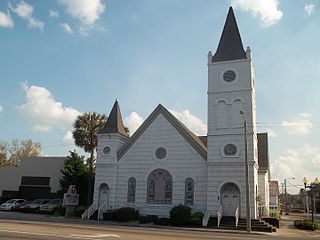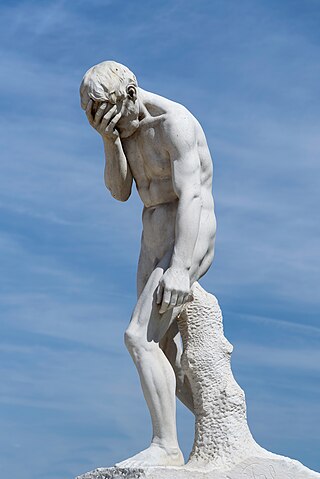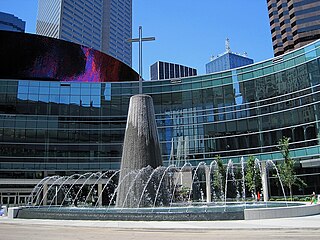Related Research Articles
Baptists form a major branch of evangelical Protestantism distinguished by baptizing only professing Christian believers, and doing so by complete immersion. Baptist churches also generally subscribe to the doctrines of soul competency, sola fide, sola scriptura and congregationalist church government. Baptists generally recognize two ordinances: baptism and communion.

Bob Jones University (BJU) is a private evangelical university in Greenville, South Carolina. It is known for its conservative cultural and religious positions. The university, with approximately 3,000 students, is accredited by the Southern Association of Colleges and Schools Commission on Colleges (SACSCOC) and the Transnational Association of Christian Colleges and Schools. In 2017, the university estimated the number of its graduates at 40,184.

The Southern Baptist Convention (SBC), alternatively the Great Commission Baptists (GCB), is a Baptist Christian association of churches based in the United States. It is the world's largest Baptist denomination, and the largest Protestant and second-largest Christian denomination in the United States. In 1845 the Southern Baptists separated from the Triennial Convention in order to support slavery, which the southern churches regarded as "an institution of heaven". During the 19th and most of the 20th century, it played a central role in Southern racial attitudes, supporting racial segregation and the Lost Cause of the Confederacy while opposing interracial marriage. In 1995, the organization apologized for its history. Since the 1940s, it has spread across the United States, having member churches across the country and 41 affiliated state conventions.
During the history of the Latter Day Saint movement, the relationship between Black people and Mormonism has included enslavement, exclusion and inclusion, official and unofficial discrimination, and friendly ties. Black people have been involved with the Latter Day Saint movement since its inception in the 1830s. Their experiences have varied widely depending on the specific denomination within Mormonism, and the time in history of their involvement. From the mid-1800s to 1978, Mormonism's largest denomination, the Church of Jesus Christ of Latter-day Saints barred Black women and men from participating in ordinances of its temples necessary for the highest level of salvation, prevented most men of Black African descent from being ordained to the church's lay, all-male priesthood, supported racial segregation in its communities and schools, taught that righteous Black people would be made White after death, and opposed interracial marriage. The temple and priesthood racial restrictions were lifted by top leaders in 1978. In 2013 the church disavowed its previous teachings on race for the first time.

Christian views on slavery are varied regionally, historically and spiritually. Slavery in various forms has been a part of the social environment for much of Christianity's history, spanning well over eighteen centuries. In the early years of Christianity, slavery was an established feature of the economy and society in the Roman Empire, and this persisted in different forms and with regional differences well into the Middle Ages. Saint Augustine described slavery as being against God's intention and resulting from sin. In the eighteenth century the abolition movement took shape among Christians across the globe.
The doctrine of the serpent seed, also known as the dual-seed or the two-seedline doctrine, is a controversial and fringe Christian religious belief which explains the biblical account of the fall of man by stating that the Serpent mated with Eve in the Garden of Eden, and the offspring of their union was Cain. This event resulted in the creation of two races of people: the wicked descendants of the Serpent who were destined for damnation, and the righteous descendants of Adam who were destined to have eternal life. The doctrine frames human history as a conflict between these two races in which the descendants of Adam will eventually triumph over the descendants of the Serpent.

The black church is the faith and body of Christian denominations and congregations in the United States that minister predominantly to, and are led by, African Americans, as well as these churches collective traditions and members. The term "black church" may also refer to individual congregations, including in traditionally white-led denominations.

The curse of Cain and the mark of Cain are phrases that originated in the story of Cain and Abel in the Book of Genesis. In the stories, if someone harmed Cain, the damage would come back sevenfold. Some interpretations view this as a physical mark, whereas other interpretations see the "mark" as a sign, and not as a physical mark on Cain himself. The King James Version of the Bible reads "set a mark upon Cain".

In the Book of Genesis, the curse of Ham is described as a curse which was imposed upon Ham's son Canaan by the patriarch Noah. It occurs in the context of Noah's drunkenness and it is provoked by a shameful act that was perpetrated by Noah's son Ham, who "saw the nakedness of his father". The exact nature of Ham's transgression and the reason Noah cursed Canaan when Ham had sinned have been debated for over 2,000 years.

Segregation academies are private schools in the Southern United States that were founded in the mid-20th century by white parents to avoid having their children attend desegregated public schools. They were founded between 1954, when the U.S. Supreme Court ruled that segregated public schools were unconstitutional, and 1976, when the court ruled similarly about private schools.
Approximately 15.3% of Americans identify as Baptist, making Baptists the second-largest religious group in the United States, after Roman Catholics. Baptists adhere to a congregationalist structure, so local church congregations are generally self-regulating and autonomous, meaning that their broadly Christian religious beliefs can and do vary. Baptists make up a significant portion of evangelicals in the United States and approximately one third of all Protestants in the United States. Divisions among Baptists have resulted in numerous Baptist bodies, some with long histories and others more recently organized. There are also many Baptists operating independently or practicing their faith in entirely independent congregations.

Wallie Amos Criswell, was an American pastor, author, and a two-term elected president of the Southern Baptist Convention from 1968 to 1970. As senior pastor of the First Baptist Church of Dallas for five decades he became widely known for expository biblical preaching at a popular level, and is regarded as a key figure in the late 1970s "Conservative Resurgence" within the Southern Baptist Convention.

Religion of black Americans refers to the religious and spiritual practices of African Americans. Historians generally agree that the religious life of black Americans "forms the foundation of their community life". Before 1775 there was scattered evidence of organized religion among black people in the Thirteen Colonies. The Methodist and Baptist churches became much more active in the 1780s. Their growth was quite rapid for the next 150 years, until their membership included the majority of black Americans.

First Baptist Dallas is a Baptist megachurch located in Dallas, Texas. It is affiliated with the Southern Baptist Convention. It was established in 1868. The church is considered influential in Dallas and among evangelical Christians in the United States, because of its community involvement through 21 missions.

Basil Manly Sr. was an American planter, preacher and chaplain best known as the author of the Alabama Resolutions, which formed part of the argument for creation of the Southern Baptist Convention on proslavery grounds.

Robert James Jeffress Jr. is an American Southern Baptist pastor, author, radio host, and televangelist. He is the senior pastor of the 14,000-member First Baptist Church, a megachurch in Dallas, Texas, and is a Fox News Contributor. His sermons are broadcast on the television and radio program Pathway to Victory, which is broadcast on more than 1,200 television stations in the United States and 28 other countries, and is heard on 900 stations and broadcast live in 195 countries.

The Latter Day Saint movement has had varying and conflicting teachings on slavery. Early converts were initially from the Northern United States and opposed slavery, believing that their opposition was supported by Mormon scripture. After the church base moved to the slave state of Missouri and gained Southern converts, church leaders began to enslave people. New scriptures instructing Latter-Day Saints not to intervene in the lives of the enslaved people were revealed. A few enslavers joined the church, and when they moved to Nauvoo, Illinois, they illegally took their enslaved people with them, even though Illinois was a free state.

Racial segregation of churches in the United States is a pattern of Christian churches maintaining segregated congregations based on race. As of 2001, as many as 87% of Christian churches in the United States were completely made up of only white or African-American parishioners.

Teachings on the biblical curse of Cain and the curse of Ham in the Church of Jesus Christ of Latter-day Saints, and their effects on Black people in the LDS Church have changed throughout the church's history. Both church founder Joseph Smith, and his most popular successor Brigham Young taught that Black people were under the curse of Ham, and the curse of Cain. Smith and Young both referred to the curses as a justification for slavery. They also taught that dark skin marked people of African ancestry as cursed by God. In Smith's revisions of the King James Bible, and production of the Book of Abraham he traced their cursed state back to the curses placed on Cain and Ham, and linked the two curses by positioning Ham's Canaanite posterity as matrilinear descendants of Cain.
Joseph Smith's views on Black People varied during his lifetime. As founder of the Latter Day Saint movement, he included Black people in many ordinances and priesthood ordinations, but held multi-faceted views on racial segregation, the curses of Cain and Ham, and shifted his views on slavery several times, eventually coming to take an anti-slavery stance later in his life.
References
- ↑
- Goldenberg, David M. (2005). "What did Ham do to Noah?". In Stemberger, Günter; Perani, Mauro (eds.). The Words of a Wise Man's Mouth Are Gracious. Walter de Gruyter. p. 168. ISBN 9783110188493.
- Lulat, G. (2005). A History of African Higher Education from Antiquity to the Present: A Critical Synthesis. Santa Barbara: ABC-CLIO. pp. 85–86. ISBN 9780313068669.
- Metcalf, Alida C. (2005). Go-betweens and the Colonization of Brazil, 1500–1600 (1st ed.). Austin: University of Texas Press. p. 164. ISBN 978-0292712768.
- ↑ "Paul's Letter to American Christians". King Research and Education Institute, Stanford University. Archived from the original on October 2, 2013.
- ↑ Boles, John B. (October 2003). "Noah's Curse: The Biblical Justification of American Slavery". The American Historical Review. 108 (4): 1150–1151. doi:10.1086/ahr/108.4.1150. ISSN 1937-5239.
- ↑ Fredrickson, George M. (2015). Racism: A Short History. Princeton: Princeton University Press. p. 44. doi:10.1515/9781400873678. ISBN 9781400873678.
- ↑ "Land of the Till Murder". Ebony . April 1956. Archived from the original on 2005-03-11.
- ↑ Miller, Randall M.; Smith, John David (1988). Dictionary of Afro-American Slavery . Westport, CT: Greenwood Press. p. 78. ISBN 0-313-23814-6.
Slaves were accepted for membership in the same manner as whites. After expressing a desire to join a church, one was required to relate his or her religious experience. If the congregation was favorably impressed by one's testimony, the applicant was accepted into the fellowship and was baptized. When black church members moved from one community to another, they were given letters of dismissal which they might place with another Baptist church. Black church members worshiped in the sanctuary with whites, participated in the service of Holy Communion, and contributed to help support the various programs of the denomination. Still blacks and females in antebellum Baptist churches held a membership status subordinate to that of white adult males, since that group determined denominational policies and procedures.
- ↑ Feldman, Glenn (2005). Politics and Religion in the White South. The University Press of Kentucky. ISBN 9780813123639. pp. 106-109.
- ↑ Daniel 1955. Title page description.
- ↑ Miller, Edward H. (2015). Nut Country: Right-Wing Dallas and the Birth of the Southern Strategy. University of Chicago Press. ISBN 9780226205410. pp. 71-74; 176.
- ↑ Herring, Taylor O. (2015). "'All That is Necessary for the Triumph of Evil is That Good Men Do Nothing': Anticommunism, Protestant Christianity, and State Sovereignty in the Civil Rights Era South Archived 2022-05-17 at the Wayback Machine ". University of Southern Mississippi. Honors Theses. pp. 23-25.
- ↑ Dallas FBI file 105-484A
- ↑ Weinberg, Carl R. (2021). Red Dynamite: Creationism, Culture Wars, and Anticommunism in America. Cornell University Press. ISBN 9781501759307.
- ↑ Chapell, David L. (2009). A Stone of Hope: Prophetic Religion and the Death of Jim Crow. University of North Carolina Press. ISBN 9780807895573.
- ↑ Kinder, Donald R. Lynn M. Sanders (1996). Divided by Color: Racial Politics and Democratic Ideals. University of Chicago Press. ISBN 9780226435749. p. 221.
- ↑ Turner, 225, 369
- ↑ Kunnerth, Jeff (21 June 1995). "Baptists Renounce Racist Past". Orlando Sentinel.